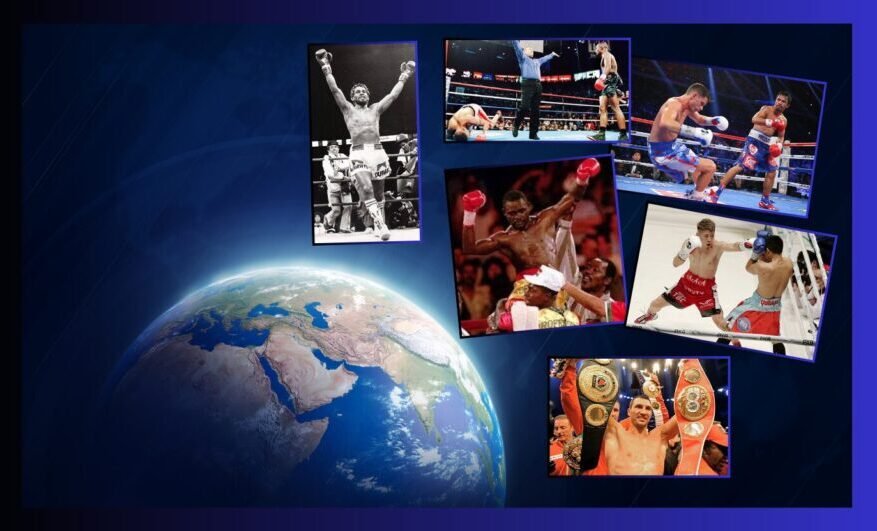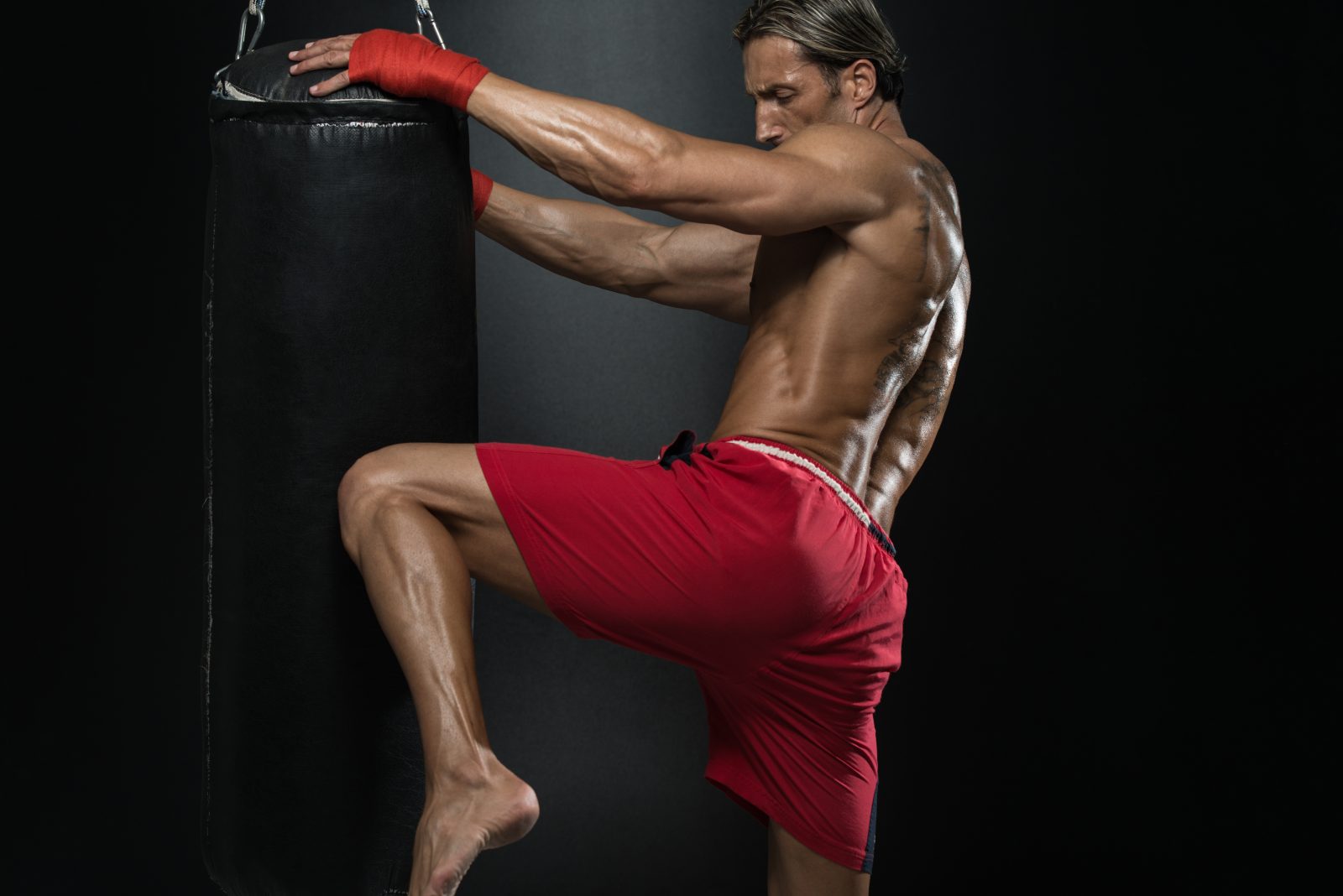Britain and America may have built the foundations of boxing — but the sport didn’t stop there. Once U.S. media beamed it across the airwaves, the world wanted in. From Havana gyms to Tokyo arenas, fighters everywhere began reshaping the game with their own styles, rhythms, and traditions. Each culture left its mark, turning boxing into a truly global language of combat.
Table of Contents
📺 The Global Ripple Effect
Boxing didn’t take long to spread beyond its early hubs. What began as a colonial export — shipped in military trunks and taught on docks and parade grounds — was soon redefined across continents. From the barrios of Latin America to the cold gyms of Eastern Europe, boxing became a statement — defiance, pride, intent. Its global impact was only beginning.
As the 20th century rolled on, global fighters stopped chasing Western approval — they started collecting crowns of their own. Each region added something distinct: style, rhythm, psychology, politics, cultural pride. The ring became a proving ground where nations long kept in the shadows could punch their way into history.
Boxing had crossed borders — it belonged to the world now. And from those new corners of the globe, six nations rose to redefine what greatness looked like.
🥇 The Elite – Boxing’s Global Powerhouses
We’ve already covered two giants of the the sport — United States and the United Kingdom — in dedicated posts. But boxing’s story didn’t end there. Other nations rose to carve out their own legacies, each forging distinct styles, philosophies, and champions that reshaped the ring. These six stand apart as the sport’s global powerhouses — nations whose fighters and traditions have influenced boxing far beyond their borders.
🇲🇽 Mexico
Iron Chins and Body Shots
In Mexico, boxing quickly grew into a national obsession, woven into the country’s identity — a perfect storm of machismo, artistry, and grit. In a country where dignity, toughness, and community are sacred, boxing was seen as a proving ground for manhood and national pride. From border towns to sprawling cities, the gym became a temple where the working class could rise through pain, courage, and fists.

From Julio César Chávez’s relentless body attacks to Canelo Álvarez’s polished precision, Mexico forged a style defined by pressure, iron chins, and warrior pride — a legacy written in blood and body shots.
Click links below for more on the influence of Latin American Boxing.
🥊 Fighting Style
Mexican boxers are known for:
- Relentless pressure – Constant forward motion, cutting off the ring with ruthless efficiency.
- Body attack specialists – Some of the greatest liver-shot artists in history hail from Mexico.
- Iron chins and warrior spirit – Willing to take three shots to land one if that’s what it takes.
- Volume and grit – Fights are often battles of attrition, fought on the front foot.
This “never-back-down” style—often called Mexican-style boxing—has become a global archetype, celebrated by fans for its raw entertainment and unfiltered bravery.
🌟 Notable Fighters
- Julio César Chávez – The ultimate embodiment of Mexican boxing, with 87 straight wins and a relentless style that crushed opponents under pressure.
- Salvador Sánchez – A featherweight genius whose timing, counters, and ring IQ still inspire.
- Erik Morales & Marco Antonio Barrera – Fierce rivals whose trilogy redefined modern Mexican boxing wars.
- Canelo Álvarez – A new-era icon who blends the classic Mexican body game with refined head movement and counterpunching.
💪 Training Ethos
Mexican gyms are intense environments focused on fundamentals, repetition, and toughness. Sparring is often hard and frequent. Fighters drill bodywork until it becomes second nature. Roadwork is sacred. The culture emphasises humility, heart, and a willingness to suffer in silence. It’s common to hear fighters say, “You have to leave a piece of yourself in the gym every day.”
Mexico has given the boxing world more than just great champions — it’s gifted a style. One that millions try to emulate, but few can truly own. It’s a style born from struggle, hardened by tradition, and fuelled by a relentless desire to fight until the final bell.
🎁🥊 What Mexico Brought to Boxing
Mexico gave the world its most iconic pressure style. Fighters brought relentless aggression, granite chins, and body-punching mastery into the spotlight. “Mexican-style” became a global badge of honour — proof that heart, grit, and willpower can be as decisive as skill.
🥇🇨🇺 Cuba
The Amateur Kingdom
Boxing in Cuba became a state-sponsored pursuit of perfection following the 1959 revolution. Fidel Castro’s government banned professional boxing in 1962, shifting all focus to amateur competition. The aim wasn’t money or fame—it was Olympic supremacy, proof that the revolution could outbox the world. Cuban boxers were trained to be warriors of the state, carrying the flag on their gloves and the revolution in their hearts.
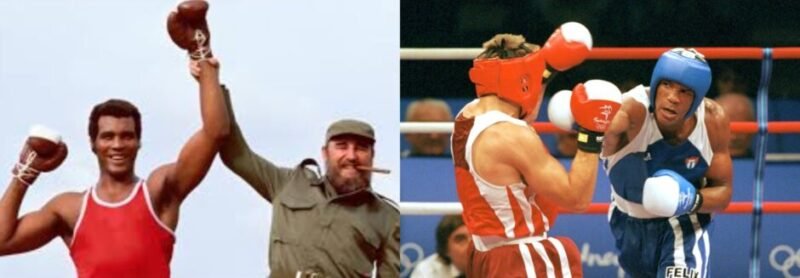
Cuba ruled the amateurs with Teófilo Stevenson’s defiant brilliance and Félix Savón’s dominance — a boxing school of skill, movement, and national pride that reshaped the sport without ever selling out to the pros.
Click links below for more on the influence of Cuban Boxing.
🥊 Fighting Style
Cuban boxers are known for:
- Slick defence – Exceptional head movement, distance control, and evasiveness.
- Fluid footwork – Lateral movement and pivots that frustrate aggressive opponents.
- Sharp counters and feints – A cerebral, trap-setting approach to breaking rhythm.
- Point scoring efficiency – Prioritising clean hits and ring control, especially under amateur rules.
Their style—often called The Cuban School of Boxing—combines the elegance of fencing with the precision of chess. It’s not built for bar fights or brawls, but for winning on skill, angles, and efficiency.
🌟 Notable Fighters
- Teófilo Stevenson – Three-time Olympic gold medallist and national hero who turned down pro offers saying, “What is a million dollars compared to the love of eight million Cubans?”
- Félix Savón – Another three-time Olympic champion who embodied the dominance of the Cuban system in heavyweight competition.
- Guillermo Rigondeaux – A master of defence and timing, Rigondeaux defected and became a world champion despite his late start in the pro ranks.
- Joel Casamayor, Yuriorkis Gamboa, Erislandy Lara – Elite amateurs who defected and found success in the professional circuit, often displaying Cuban traits like slick counters and superior ring IQ.
💪 Training Ethos
Cuban fighters are raised in rigorous national academies, often selected as children and trained under full-time government support. Training focuses on:
- Perfecting technique before full contact
- Shadowboxing and movement drills as core components
- Controlled sparring with an emphasis on learning, not hurting
- Mental and tactical conditioning to out-think rather than overpower opponents
Defection is often the only path to a professional career. Fighters risk everything — family, safety, homeland — for a chance to test themselves on the global stage. Those who stay become Olympic legends. Those who leave chase the belts they were never allowed to fight for back home.
🎁🥊 What Cuba Brought to Boxing
Cuba built the world’s most technically refined amateur system. Its fighters brought artistry, evasiveness, and chess-like discipline into the spotlight. Even pros worldwide study the Cuban approach, knowing that behind the politics lies a school of boxing that teaches perfection before aggression.
🥇🇵🇷 Puerto Rico
Island of Champions
Boxing is woven into Puerto Rico’s cultural DNA. For a small island, its output has been astonishing — producing more world champions per capita than anywhere else on Earth. In barrios and coastal towns, boxing gyms became safe havens where discipline offered escape from poverty and violence. Puerto Rican fighters carried both personal pride and national identity into the ring, representing an island that turned small gyms into global factories of champions.

Puerto Rico punched far above its size — Wilfredo Gómez’s ruthless precision and Félix ‘Tito’ Trinidad’s explosive power carried the island’s pride onto the global stage.
Click links below for more on the influence of Puerto Rican Boxing.
🥊 Fighting Style
Puerto Rican fighters are known for a blend of grit and flair:
- Heavy hands – Knockout power, especially in the lighter divisions.
- Slick movement – Balanced footwork, sharp counters, and defensive awareness.
- Two-way toughness – Willingness to box smart but trade when necessary.
- Showmanship with substance – Often able to excite crowds while staying fundamentally sharp.
This mixture of craft and power gave Puerto Rican boxing a unique balance—fighters who could win on skill, or on heart.
🌟 Notable Fighters
- Wilfredo Gómez – “Bazooka” Gómez, one of history’s greatest knockout artists at super bantamweight.
- Wilfred Benítez – A defensive prodigy, youngest-ever world champion at 17.
- Félix Trinidad – The beloved “Tito,” a welterweight destroyer with thunder in his gloves.
- Miguel Cotto – Four-division world champion, master of body-punching and technical grit.
Together, these names made Puerto Rico a cornerstone of the sport, producing boxers idolised across generations.
💪 Training Ethos
Puerto Rican boxing gyms emphasise sharp fundamentals, heavy bag power drills, and relentless sparring. Coaches foster mental toughness alongside flair, pushing fighters to embody both elegance and ferocity. The island’s fighters became heroes for Puerto Rico — and for Latin communities worldwide.
🎁🥊 What Puerto Rico Brought to Boxing
Greatness needs no grand stage — only heart and precision. Puerto Rican champions combined artistry with knockout danger, giving the world a style both crowd-pleasing and elite. In the global boxing conversation, Puerto Rico stands shoulder to shoulder with nations far larger in size, but rarely in influence.
🇵🇭 The Philippines
The Colonial Seed That Took Root
Boxing was introduced to the Philippines during American colonial rule in the early 20th century, alongside other U.S. exports like baseball and jazz. The Filipinos took the sport and remade it in their image — fast, fearless, and full of heart. In a country marked by poverty, resilience, and political struggle, for many, the ring wasn’t escape — it was redemption. The ring became a stage where Filipino grit and pride could shine against the world.
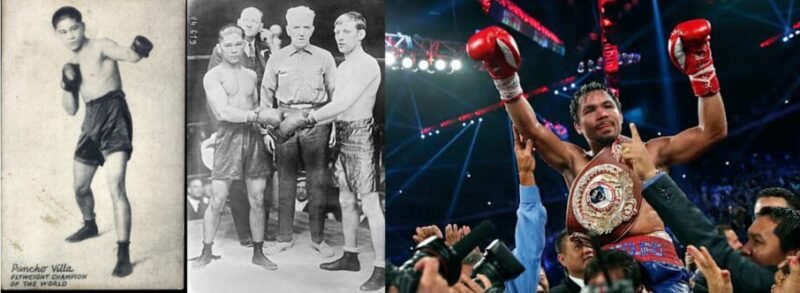
From Pancho Villa blazing the trail in the 1920s to Manny Pacquiao conquering eight divisions, the Philippines proved its fighters could shock the world with speed, heart, and ferocity.
Click links below for more on the influence of Filipino Boxing.
🥊 Fighting Style
Filipino boxers are known for:
- Explosive speed – Fast hands and unpredictable angles.
- Southpaw chaos – Many Filipino fighters favour the southpaw stance, using it to frustrate conventional opponents.
- Volume punching – Relentless combinations and pressure.
- Warrior heart – Willingness to take risks and trade blows.
This dynamic style has thrilled fans and overwhelmed opponents. It’s aggressive, awkward, and dangerous—often carried by sheer momentum and heart.
🌟 Notable Fighters
- Pancho Villa – The first Filipino world champion (1923), and a trailblazer who proved that Asian fighters could hang with the best.
- Flash Elorde – Elegant and elusive, one of the most respected super featherweights in history.
- Manny Pacquiao – A global icon and eight-division world champion, Pacquiao’s rise from street poverty to the peak of the sport symbolised hope, grit, and the Filipino spirit.
💪 Training Ethos
Boxing gyms in the Philippines are often humble — open-air spaces with rusted equipment and makeshift bags. But what they lack in resources, they make up for in hunger. Fighters train with raw intensity, often focusing on roadwork, mitt drills, and sparring over advanced tech. Coaches emphasise toughness, instinct, and a relentless pace over textbook form.
Filipino boxing remains one of the most emotional, unpredictable, and beloved styles in the world. Its legacy is cemented in global consciousness through the fists of its greatest son — Pacquiao — but its heart lies in every dusty gym where the next warrior trains barefoot under the sun.
🎁🥊 What the Philippines Brought to Boxing
The Philippines gave boxing chaos and heart in equal measure. Their fighters brought southpaw unpredictability, furious volume, and the spirit of never backing down. Pacquiao cemented the nation’s place in history — yet it’s their style, a mix of hunger and hurricane, that remains their true legacy.
🥋🇯🇵 Japan
Precision, Honour, and Unrelenting Discipline
Boxing in Japan took root in the early 20th century but didn’t explode until after WWII, when American soldiers stationed in the country introduced Western sports. The Japanese absorbed boxing into their cultural code, fusing Western fists with Eastern discipline. Deeply influenced by Bushidō values like honour, stoicism, and relentless self-improvement, boxing became a respected discipline. Fighters weren’t just athletes — they were craftsmen perfecting a lifelong trade.
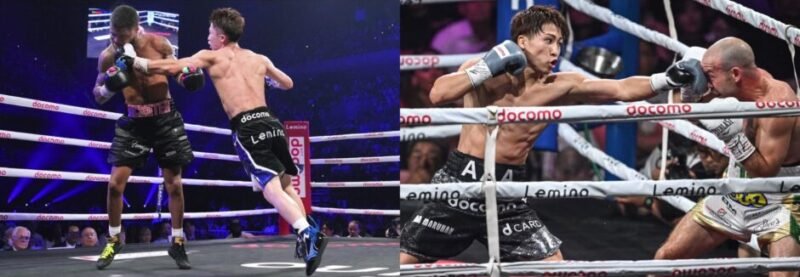
Japanese boxing fused discipline with precision, producing warriors of quiet resolve. Today, Naoya Inoue carries that legacy as the ‘Monster,’ redefining power and perfection in the ring.
Click links below for more on the influence of Japanese Boxing.
🥊 Fighting Style
Japanese fighters are respected for their tight technique, pressure-based attack, and indomitable will. Many embrace a style of controlled aggression—staying on the front foot while remaining technically sound.
Japanese boxers are known for:
- Textbook fundamentals – crisp punches, tight guards, clean mechanics.
- Unshakable resolve – rarely give up, often endure massive punishment to win.
- Non-flashy but lethal – focused more on discipline and repetition than showmanship.
Even in losses, Japan’s best are admired for their grit and grace. Fighters like Masahiko “Fighting” Harada and Toshiaki Nishioka earned global respect, showing that Japan could not only compete—but lead.
🌟 Notable Fighters
- Naoya Inoue (“The Monster”) – One of the most feared pound-for-pound fighters on Earth. A generational phenom with KO power, speed, and surgical accuracy. He represents the next evolution of Japanese boxing—deadly precision without wasted motion.
💪 Training Ethos
Japanese boxing gyms operate like dojos—military in discipline, obsessive in detail. Fighters often:
- Live in the gym under their coach’s supervision
- Drill footwork and mechanics for months before even sparring
- Embrace repetitive, hard work over flash or shortcuts
This produces fighters who are mentally durable, technically sharp, and fight-ready under pressure. Even regional-level Japanese fighters are often more technically sound than their Western counterparts.
Japan produces fewer champions — every one of them forged like steel. With discipline as its backbone and Inoue leading a new generation, Japan remains Asia’s beating heart in global boxing.
🎁🥊 What Japan Brought to Boxing
Japan fused Western boxing with Bushidō values, proving discipline and mental endurance could rival raw aggression. Their fighters showed the world that relentless fundamentals and stoic will can be just as fearsome as flash or power. Inoue’s rise only underlines Japan’s gift: precision sharpened into an art form.
🥊🇺🇦 Ukraine
Soviet Science Meets National Grit
Boxing in Ukraine was forged in the crucible of the Soviet sports machine, where combat sports were state-sponsored, methodical, and highly competitive. Talented youth were selected early and trained with military-style discipline in elite academies. After independence in 1991, Ukraine inherited the infrastructure but replaced Soviet dogma with grit sharpened by hardship—creating a generation of elite fighters who fought not for the state, but for legacy.

Ukraine turned footwork and ring IQ into an art form. Lomachenko and Usyk embody this legacy—masters of movement, breaking down giants with precision, patience, and brilliance.
Click links below for more on the influence of Ukrainian Boxing.
🥊 Fighting Style
Ukrainian boxing is a hybrid of cerebral precision and physical toughness, rooted in amateur fundamentals but sharpened for the pro game. Hallmarks of the Ukrainian style include:
- Elegant footwork – especially lateral movement and angle creation
- Ring IQ and distance control – based on years of tournament-level amateur bouts
- Pacing and composure – rarely rushing, always calculating
- Adaptability – able to switch rhythm mid-fight and change strategies on the fly
This blend creates fighters who out-think and out-manoeuvre opponents rather than just outpunching them.
🌟 Notable Fighters
- Vasiliy Lomachenko – A technical genius with “Matrix-like” movement, multiple-time world champion, and two-time Olympic gold medallist. His style fuses ballet-like footwork with relentless offensive creativity.
- Oleksandr Usyk – Another double Olympic gold medallist, undisputed cruiserweight king, and now a dominant heavyweight. Usyk brings relentless pressure, high-volume feints, and unmatched movement to a weight class known for slow brawlers.
💪 Training Ethos
Ukrainian training still bears the mark of its Soviet past:
- Early talent identification and long-term athlete development
- Cold exposure, outdoor conditioning, and psychological hardening.
- Laser focus on technique and drills before competition
There’s a cultural emphasis on stoicism, humility, and resilience. Ukrainian fighters are often quiet outside the ring but ferocious inside it, with a mindset shaped by political upheaval, economic struggle, and historical hardship.
Ukraine’s rise wasn’t sport — it was defiance made flesh. In a region torn by conflict, its boxers fight with purpose, poise, and pride. Together, Lomachenko and Usyk won belts — and redefined modern boxing’s tactical ceiling.
🎁🥊 What Ukraine Brought to Boxing
Ukraine turned Soviet science into artistry. Their fighters brought footwork wizardry, unseen angles, and a cerebral approach that dissected opponents rather than overwhelmed them. From Klitschko dominance to Lomachenko’s matrix-like movement, Ukraine’s influence is modern boxing IQ at its peak.
🥈 Notable Nations
Strong Traditions, Fierce Fighters
Not every country reshaped boxing’s global style, but many left lasting fingerprints. From Argentina’s cold precision to Thailand’s flyweight dynasties, these nations forged champions, carved out identities, and delivered unforgettable nights. They didn’t write the global playbook — they added new chapters, proving boxing’s strength lives in local pride as much as in world titles.
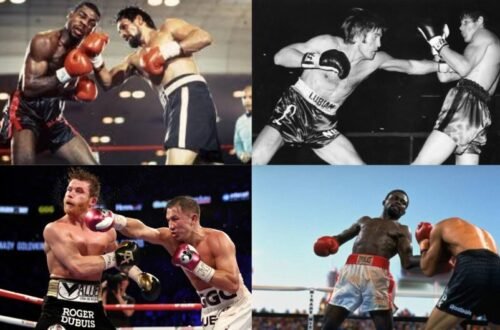
Roberto Durán, Carlos Monzón, Gennady Golovkin, and Azumah Nelson — four icons who carried nations on their shoulders. Each brought a distinct style and spirit, leaving legacies that shaped boxing far beyond their borders.
Click links below for more on the influence of the rest of the world in the sport of Boxing.
🇦🇷 Argentina – Cold Control and Southpaw Swagger
Key Cities: Buenos Aires, Santa Fe.
Famous Fighters: Carlos Monzón, Sergio “Maravilla” Martínez.
Strengths: Iron discipline, counterpunching finesse, mental toughness.
Argentina carves its place with Monzón’s icy dominance and Martínez’s slick southpaw wizardry. Fighters mix grit with guile—methodical, patient, and lethal when the opening comes.
🇵🇦 Panama – Hands of Stone and Canal Pride
Key Cities: Panama City, Colón.
Famous Fighters: Roberto Durán, Ismael Laguna, Eusebio Pedroza.
Strengths: Lightweight mastery, ferocity, technical brilliance.
Panama’s fighters blend slick technique with raw aggression. Durán brought ferocity, Laguna finesse, and Pedroza defensive craft—together proving a small nation could rule the lightweights with outsized impact.
🇨🇴 🇻🇪 Latin America
Nations like Colombia and Venezuela built fierce amateur programs and produced Olympic gold before fading from headlines. Their fighters keep Latin boxing’s heart beating — proof the flame burns even off-camera.
🇷🇺 Russia – Cold Power, Iron Discipline
Key Cities: Moscow, St. Petersburg, Yekaterinburg
Famous Fighters: Sergey Kovalev, Artur Beterbiev.
Strengths: Amateur depth, crushing power, relentless pressure.
Russia’s system produces stoic machines. Fighters like Kovalev and Beterbiev embody heavy-handed destruction, with a style built on Soviet precision and punishing forward momentum.
🇰🇿 Kazakhstan – Power and Soviet Precision
Key Cities: Almaty, Astana.
Famous Fighters: Gennady “GGG” Golovkin, Vassiliy Jirov.
Strengths: Olympic pedigree, clean technique, thunderous power.
Kazakhstan punches well above its weight, producing world-class champions through a Soviet-rooted amateur system. GGG embodies the Kazakh style: high guard, forward march, and chilling knockout power.
🇿🇦 South Africa – Underdogs with Bite
Key Cities: Johannesburg, Cape Town.
Famous Fighters: “Baby” Jake Matlala, Gerrie Coetzee, Corrie Sanders.
Strengths: Speed, toughness, unpredictable flair.
South Africa’s boxing legacy runs through both black and white communities, producing fighters who overcome apartheid barriers. Known for fast hands, grit, and shock upsets on the world stage.
🇨🇦 Canada – Guts and Granite Chins
Key Cities: Montreal, Toronto.
Famous Fighters: George Chuvalo, Arturo Gatti, Lennox Lewis.
Strengths: Durability, crowd-pleasing wars, heavyweight pedigree.
Canadian boxing is marked by Chuvalo’s iron jaw, Gatti’s blood-and-guts thrillers, and Lewis’ calculated dominance. A country that produces both brawlers and brilliant technicians.
🇦🇺 Australia – Brawlers and Breakthroughs
Key Cities: Sydney, Melbourne.
Famous Fighters: Jeff Fenech, Kostya Tszyu (Russia-born, Aussie legend).
Strengths: Aggression, toughness, crowd energy.
Australian fighters are often all-action, feeding off raucous crowds. Fenech’s ferocity and Tszyu’s precision help Australia punch far above its weight.
🇹🇭 Thailand – Volume, Chin, and Stamina
Key Cities: Bangkok, Nakhon Ratchasima.
Famous Fighters: Khaosai Galaxy, Srisaket Sor Rungvisai.
Strengths: Iron-willed fighters, seamless Muay Thai crossover, light division legends.
Thailand dominates in the lighter divisions, producing warriors who outlast and overwhelm. Endurance assassins—fighters who carve opponents down with ceaseless output, forged in Muay Thai’s unforgiving camps.
🇰🇷 South Korea – Relentless Pressure Cookers
Key Cities: Seoul, Busan.
Famous Fighters: Jung-Koo Chang, Kim Duk-Koo.
Strengths: Endless volume, warrior spirit, granite toughness.
Korean fighters become cult legends for their insane work rate and refusal to quit. Chang’s dominance at light flyweight shows how pressure and grit overwhelm flashier opponents.
🇪🇺 Continental Europe – Depth and Diversity
Key Cities: Rome, Berlin, Budapest, Warsaw.
Famous Fighters: László Papp (Hungary), Max Schmeling (Germany), Dariusz Michalczewski (Poland).
Strengths: Olympic pedigree, technical schooling, promotional power.
Carpentier, France’s war-hero celebrity, showed Europe’s reach early. Since then the continent has been a patchwork of strengths: Italy and Hungary dominate in the amateurs, Germany built a 90s promotional empire that still echoes today, and Poland’s fanatical crowds forged some of boxing’s wildest atmospheres.
Together, these nations remind us that boxing isn’t just built by giants—it’s a mosaic of styles, traditions, and champions, each adding its own punch to the sport’s global story.
💰🌍 The Business of Boxing Goes Global
Boxing’s map is being redrawn — not by fighters, but by financiers. The sport that once lived in smoke and spotlight now moves through boardrooms, brands, and billion-dollar deals. The modern fight isn’t just for belts, but for markets — and the arena has gone global.
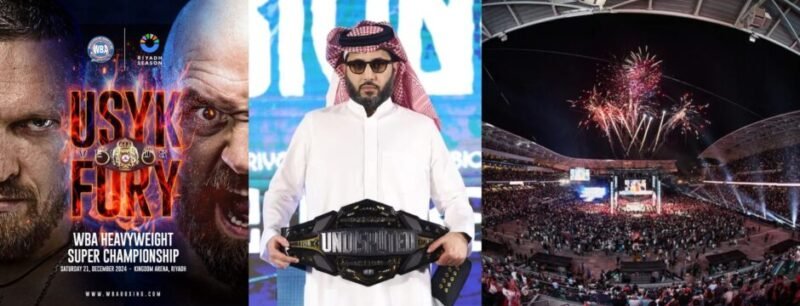
Turki Alalshikh — turning Riyadh into boxing’s new empire, where the biggest fights on earth now find their stage.
Click links below for more.
🗺️ The New Geography of the Fight Game
Once, boxing’s power lived in Las Vegas, Madison Square Garden, and Wembley.
Now, the sport’s biggest nights are brokered across time zones and currencies.
Streaming giants like DAZN and ESPN Global turned the fight game into a worldwide marketplace — where fans, not promoters, decide what sells.
Promoters like Matchroom, Top Rank, and Queensberry chase opportunity in new territories — Lagos, Tokyo, Tashkent, Riyadh.
The sport’s future isn’t local — it’s transactional.
The new power brokers aren’t bound by commissions or geography — they’re rewriting boxing’s rules by buying the spotlight itself. In the process, the sport’s old capitals—Vegas, London, New York—must now share the stage with Riyadh, Tokyo, and Tashkent.
🏟️ The Middle East Power Shift
At the center of this new order stands the Middle East, reshaping boxing’s economy almost overnight. Saudi Arabia’s “Riyadh Season” cards turned desert arenas into cathedrals of global spectacle — uniting heavyweights, networks, and rival promoters under one roof.
The region isn’t producing fighters; it’s producing empires.
As oil wealth meets entertainment politics, fighters find themselves negotiating not just opponents — but identities. Legacy now depends as much on where you fight as how you fight. The Middle East isn’t breeding champions — it’s buying the throne.
Fighters now chase promoters across continents — training in Dubai, fighting in Tokyo, and cashing cheques in Riyadh — the sport’s new geography written in currency. In a way, it’s the same story told in a new accent — the old prizefighter chasing the next purse, only now the stakes have outgrown the tavern and the tent.
The fighter still follows the money, only the money moves faster.
The next revolution in boxing won’t come from the gym floor — it’ll come from the boardroom.
🚀 Emerging Nations
Boxing’s Next Wave
Boxing’s next frontier runs on more than tradition — it runs on ambition and opportunity. These countries are building pipelines, producing breakout champions, and proving that the sport’s global map is far from finished.

From Mary Kom’s dominance in India to Cecilia Brækhus breaking barriers in Europe, breakout nations proved boxing’s future is global. Their triumphs inspire new generations to rise from every corner of the world.
Click links below for more.
🥇 Olympic Breakouts
Every rising boxing nation begins in the same place — the amateur ranks. From Havana to Tashkent, the Olympic system levels the playing field, sharpening styles, crowning new flags, and turning medal glory into professional ambition. These are the countries now stepping from podiums to pay-per-view lights.
🇺🇿 Uzbekistan – The Post-Soviet Powerhouse
- Strengths: Physically dominant, slick technicians honed in the amateur ranks
- Infrastructure: State-backed programs pump out Olympic medallists
- Trajectory: Pros like Murodjon Akhmadaliev show Uzbekistan can carry its dominance into the professional spotlight.
🇹🇷 Turkey – From Olympics to the Pros
- Strengths: Solid boxing fundamentals, consistent presence at amateur tournaments
- Infrastructure: Turkey maintains a reliable Olympic pipeline with growing gym networks
- Trajectory: Needs a breakout pro star to cement its place on the global scene.
🇮🇷 Iran – Waiting for the Breakthrough
- Strengths: Strong amateur pedigree with disciplined, technical fighters
- Infrastructure: Iran has plenty of local talent, but limited pathways to professional careers
- Trajectory: Once the first world-level pro emerges, Iran could follow Cuba’s model—discipline and grit with global reach.
🌍 African Hotbeds Beyond South Africa
Raw talent, passion, and champions who’ve already proven Africa can produce world-class fighters.
🇳🇬 Nigeria – Power and Athleticism
- Strengths: Physically imposing fighters with natural explosiveness
- Infrastructure: Long before Anthony Joshua, Dick Tiger carried Nigeria onto the world stage in the 1960s, proving African fighters could rule across divisions. Still patchy, but diaspora fighters (like Joshua) highlight Nigeria’s boxing DNA.
- Trajectory: With stronger domestic structures, Nigeria can become Africa’s next powerhouse.
🇬🇭 Ghana – The Legacy of Azumah Nelson
- Strengths: Aggressive, high-volume fighters with iron chins
- Infrastructure: Grassroots gyms remain underfunded, but passion runs deep
- Trajectory: Azumah Nelson sets the standard—future Ghanaian fighters have the blueprint to follow.
🌍 Other African Upstarts
- Africa’s fight story stretches far past its southern and western borders. From Namibia’s blue-collar gyms to Uganda’s Olympic hopefuls, the continent’s next wave is already swinging.
❄️ Northern Resurgence
Once limited by bans and restrictions, now slowly reclaiming ground.
🇳🇴 Norway – Brækhus and Beyond
- Strengths: Technical, disciplined fighters
- Infrastructure: Bans on pro boxing stunt growth, but gyms and interest expand
- Trajectory: Cecilia Brækhus cracks the ceiling—others can now push further.
🇸🇪 Sweden – New Blood in the North
- Strengths: Durable, well-schooled fighters like Badou Jack
- Infrastructure: Legal restrictions only recently lift, and pro culture is still developing
- Trajectory: With increased exposure and facilities, Sweden’s fighters can become steady contenders.
🌏 Asian Growth Markets
Building on existing Olympic and regional traditions, now producing pros with wider ambitions.
🇮🇳 India – Women Leading the Way
- Strengths: Mary Kom’s six world titles give women’s boxing global visibility
- Infrastructure: Expanding amateur base, though rural access is uneven
- Trajectory: Young, hungry prospects can turn Olympic talent into professional champions.
Each country’s power isn’t measured in medals — it’s written in momentum. They represent boxing’s restless evolution, where talent can erupt from any corner of the globe. Today’s outsiders could become tomorrow’s powerhouses, reshaping the sport’s map all over again.
🌍 The Legacy of International Boxing
From Havana to Manila, Accra to Tokyo, fighters carried their nations into the ring — turning struggle into style and hardship into heritage.
Each culture left its fingerprint on the sport — new rhythms, techniques, and legends — proving that boxing belongs to no single flag — it’s the world’s fight.
Summary
🌎 Latin America – Heart and identity. Brawlers with iron wills, body-punching mastery, and national pride. Boxing became a religion across Mexico, Puerto Rico, Argentina, and Panama.
🌎 Philippines – Speed and spirit. Southpaw unpredictability, relentless pace, and underdog fire forged icons like Manny Pacquiao.
🌎 Africa – Power and pride. Fighters turned struggle into statement, breaking barriers with raw strength and tactical brilliance — now courted by global promoters.
🌎 Japan – Precision and discipline. Bushidō values fused with Western technique to create some of the world’s most exacting fighters.
🌎 Ukraine – Science and stoicism. Soviet structure reborn as national artistry, producing cerebral masters like Lomachenko and Usyk.
🌎 Cuba – The amateur gold standard. Slick defence, perfect footwork, and state-backed dominance built boxing’s purest academy of skill.
🌏 Southeast Asia – Volume and fire. Thailand’s flyweight dynasties, Korea’s pressure cookers, and India’s hungry prospects forged legacies on stamina and heart.
🌍 Former Soviet Bloc – Iron and intellect. Russia’s wrecking balls and Kazakhstan’s tacticians carried Soviet precision into the pros, while Balkan nations keep the old flame alive.
🌍 Continental Europe – Craft and heritage. From Italy’s Olympic schools to Germany’s promotional powerhouses, Europe refined the sport’s technical backbone.
💰 Global Business & Middle East Power Shift – The new throne. Boxing’s money map has gone worldwide. Promoters and streaming giants chase markets from Lagos to Tokyo, but Riyadh now sits at the center — where oil, spectacle, and ambition collide.
🥇 Olympic Pipeline – The global factory. Nations like Uzbekistan, Turkey, and Iran turn amateur medals into pro ambition, proving the Olympic ring still forges tomorrow’s champions.
From Manila’s dusty gyms to Havana’s military academies, boxing evolved into a shared language of pain, pride, and perseverance. The next bout in boxing’s story? A modern era shaped by media, money, and the hunger to be remembered.
If you have enjoyed this post please share or feel free to comment below 🙂
Related Posts
Other Posts
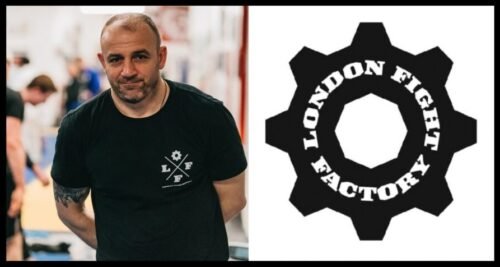



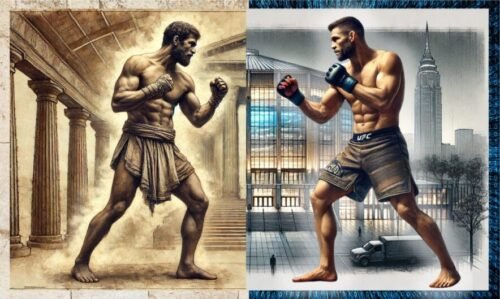
The Evolution of Combat: From Prehistory to Modern MMA
🔥 Join us on an immersive journey through 12,000 years of martial evolution—spanning continents, cultures,


